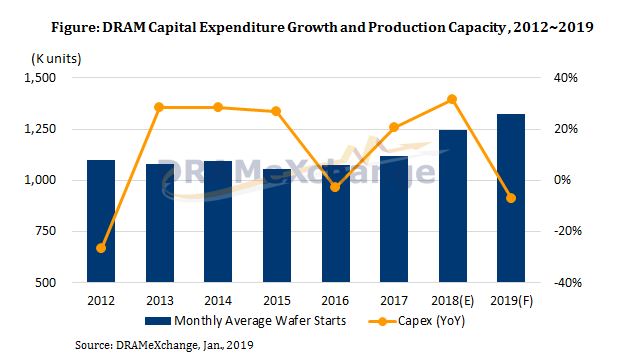- Ameya360 Component Supply Platform >
- Trade news >
- DRAM Market to See Lower Capital Expenditure and Moderated Bit Output in 2019 Due to Weak Demand
DRAM Market to See Lower Capital Expenditure and Moderated Bit Output in 2019 Due to Weak Demand
After contract prices of DRAM products turned downward sharply in 4Q18 by 10% QoQ, major DRAM manufacturers have tried to offset fall in prices by slowing down capacity expansion in 2019, as the demand outlook for PCs, servers, smartphones, and other end consumer products remains weak, reports DRAMeXchange, a division of TrendForce.
DRAMeXchange points out that, manufacturers’ capex plans are normally the most relevant indicators for their actual bit output. In 2019, the total capital expenditure for DRAM production is forecast at about $18 billion, an annual decrease of 10%. This CAPEX is at the most conservative investment level in recent years.
Samsung and SK Hynix have been the first two suppliers who announced the plans to cut their 2019 semiconductor capex. Samsung, the market leader, would spend $8 billion on capex in 2019, mainly for migration to advanced process (1Ynm) and development of new products. Samsung’s 2019 plan for wafer starts would be the most conservative in recent years. The company has also decided to terminate the production capacity expansion in its Pyeongtaek fab, which will lower Samsung’s annual output growth to around 20%, a new low over the years.
SK Hynix says its 2019 capex will be reduced to $5.5 billion, mainly for migration to advanced process and yield improvement. However, its new fab in Wuxi has just been completed, with potential capacity expansion of 30-40K pieces for the whole year of 2019. According to DRAMeXchange, SK Hynix’s output growth would be 21% YoY in 2019, slightly higher than that of Samsung.
As for Micron, who has recently announced to cut its capex to $3 billion, revised its 2019 output growth forecast downward to 15%, from almost 20% previously, in order to prevent its inventory level from increasing further. Micron would not expand its production capacity in its subsidiary Micron Memory Taiwan (formerly Rexchip), Micron Technology Taiwan (formerly Inotera), or its Hiroshima fab of former Elpida Memory, so Micron’s monthly wafer starts would remain 350K in 2019. And the output growth would only come from its migration to 1Ynm production this year. DRAMeXchange believes that Micron is more vulnerable to the drop in prices due to its weaker cost structure than Samsung and SK Hynix. Thus, Micron has to make more production and capex adjustments to cope with the price falls. As the result, Micron's market share would continue to decrease after two years with only 15% growth in bit output.
Manufacturers try to avoid price competition and maintain profitability by slowing down capacity expansion
In the oligopolistic market with no new competitors, manufacturers have tried to adjust their production plans and cut down capex to avoid price competition. In terms of profitability, the gross margins of Samsung’s and SK Hynix’s DRAM production remain nearly 80%, while that of Micron remains over 60%. With such high margins, it is reasonable for the manufacturers to be conservative in their production outlook for 2019.
On the demand front, the first quarter of 2019 will witness the weakest demand of the year due to holidays and seasonal headwinds. Moreover, there is currently no sign of demand recovery in the second quarter or afterwards. The market is still full of uncertainties due to the looming trade war between China and the U.S. Therefore, for the DRAM price trends this year, DRAMeXchange expects a quarterly decline of 15% in 1Q19, and less than 10% in 2Q19. For 2H19, the prices would continue to fall by 5% each quarter unless the demand is significantly improved.

Online messageinquiry

DRAM Prices Forecast to Crash in Q1

DRAM Outlook Dims for 2019
- Week of hot material
- Material in short supply seckilling
| model | brand | Quote |
|---|---|---|
| BD71847AMWV-E2 | ROHM Semiconductor | |
| TL431ACLPR | Texas Instruments | |
| CDZVT2R20B | ROHM Semiconductor | |
| RB751G-40T2R | ROHM Semiconductor | |
| MC33074DR2G | onsemi |
| model | brand | To snap up |
|---|---|---|
| BP3621 | ROHM Semiconductor | |
| BU33JA2MNVX-CTL | ROHM Semiconductor | |
| STM32F429IGT6 | STMicroelectronics | |
| IPZ40N04S5L4R8ATMA1 | Infineon Technologies | |
| ESR03EZPJ151 | ROHM Semiconductor | |
| TPS63050YFFR | Texas Instruments |
- Week of ranking
- Month ranking
Qr code of ameya360 official account
Identify TWO-DIMENSIONAL code, you can pay attention to


Please enter the verification code in the image below:























